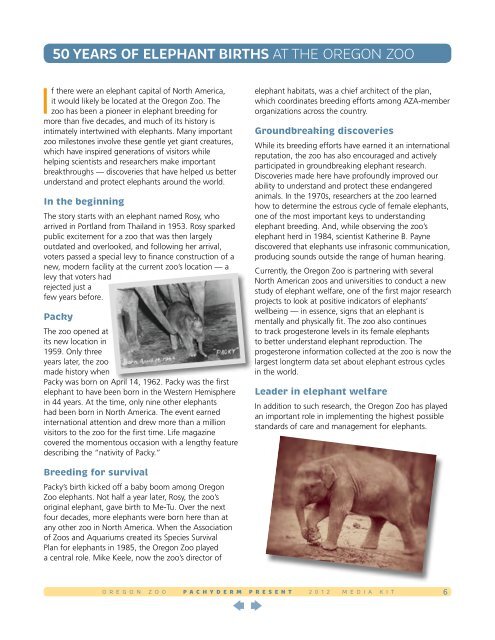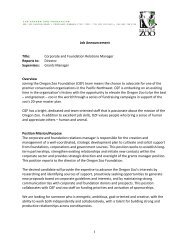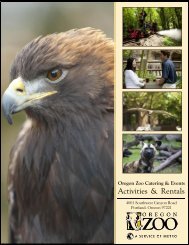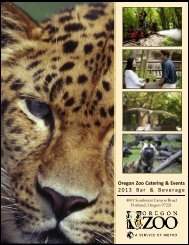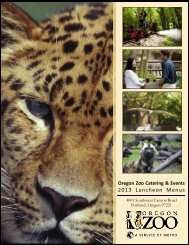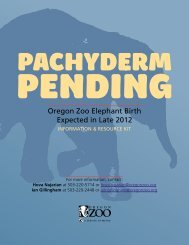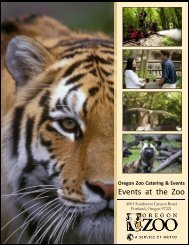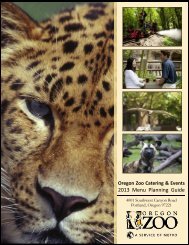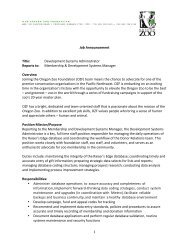You also want an ePaper? Increase the reach of your titles
YUMPU automatically turns print PDFs into web optimized ePapers that Google loves.
50 years of elephant Births at the <strong>Oregon</strong> zoo<br />
If there were an elephant capital of North America,<br />
it would likely be located at the <strong>Oregon</strong> <strong>Zoo</strong>. The<br />
zoo has been a pioneer in elephant breeding for<br />
more than five decades, and much of its history is<br />
intimately intertwined with elephants. Many important<br />
zoo milestones involve these gentle yet giant creatures,<br />
which have inspired generations of visitors while<br />
helping scientists and researchers make important<br />
breakthroughs — discoveries that have helped us better<br />
understand and protect elephants around the world.<br />
In the beginning<br />
The story starts with an elephant named Rosy, who<br />
arrived in Portland from Thailand in 1953. Rosy sparked<br />
public excitement for a zoo that was then largely<br />
outdated and overlooked, and following her arrival,<br />
voters passed a special levy to finance construction of a<br />
new, modern facility at the current zoo’s location — a<br />
levy that voters had<br />
rejected just a<br />
few years before.<br />
Packy<br />
The zoo opened at<br />
its new location in<br />
1959. Only three<br />
years later, the zoo<br />
made history when<br />
Packy was born on April 14, 1962. Packy was the first<br />
elephant to have been born in the Western Hemisphere<br />
in 44 years. At the time, only nine other elephants<br />
had been born in North America. The event earned<br />
international attention and drew more than a million<br />
visitors to the zoo for the first time. Life magazine<br />
covered the momentous occasion with a lengthy feature<br />
describing the “nativity of Packy.”<br />
elephant habitats, was a chief architect of the plan,<br />
which coordinates breeding efforts among AZA-member<br />
organizations across the country.<br />
Groundbreaking discoveries<br />
While its breeding efforts have earned it an international<br />
reputation, the zoo has also encouraged and actively<br />
participated in groundbreaking elephant research.<br />
Discoveries made here have profoundly improved our<br />
ability to understand and protect these endangered<br />
animals. In the 1970s, researchers at the zoo learned<br />
how to determine the estrous cycle of female elephants,<br />
one of the most important keys to understanding<br />
elephant breeding. And, while observing the zoo’s<br />
elephant herd in 1984, scientist Katherine B. Payne<br />
discovered that elephants use infrasonic communication,<br />
producing sounds outside the range of human hearing.<br />
Currently, the <strong>Oregon</strong> <strong>Zoo</strong> is partnering with several<br />
North American zoos and universities to conduct a new<br />
study of elephant welfare, one of the first major research<br />
projects to look at positive indicators of elephants’<br />
wellbeing — in essence, signs that an elephant is<br />
mentally and physically fit. The zoo also continues<br />
to track progesterone levels in its female elephants<br />
to better understand elephant reproduction. The<br />
progesterone information collected at the zoo is now the<br />
largest longterm data set about elephant estrous cycles<br />
in the world.<br />
Leader in elephant welfare<br />
In addition to such research, the <strong>Oregon</strong> <strong>Zoo</strong> has played<br />
an important role in implementing the highest possible<br />
standards of care and management for elephants.<br />
Breeding for survival<br />
Packy’s birth kicked off a <strong>baby</strong> boom among <strong>Oregon</strong><br />
<strong>Zoo</strong> elephants. Not half a year later, Rosy, the zoo’s<br />
original elephant, gave birth to Me-Tu. Over the next<br />
four decades, more elephants were born here than at<br />
any other zoo in North America. When the Association<br />
of <strong>Zoo</strong>s and Aquariums created its Species Survival<br />
Plan for elephants in 1985, the <strong>Oregon</strong> <strong>Zoo</strong> played<br />
a central role. Mike Keele, now the zoo’s director of<br />
O R E G O N Z O O P A C h y d e r m P r e s e n t 2 0 1 2 M E D I A K I T<br />
6


